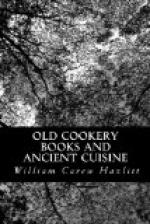“Butter and sage are now the wholesome Breakfast, but fresh cheese and cream are meat for a dainty mouth; the early Peascods and Strawberries want no price with great Bellies; but the Chicken and the Duck are fatted for the Market; the sucking Rabbet is frequently taken in the Nest, and many a Gosling never lives to be a Goose.”
Even so late as the succeeding reign, Breton speaks of the good cheer at Christmas, and of the cook, if he lacks not wit, sweetly licking his fingers.
The storage of liquids became a difficult problem where, as among our ancestors, glazed pottery was long unknown; and more especially with regard to the supply of water in dry seasons. But so far as milk was concerned, the daily yield probably seldom exceeded the consumption; and among the inhabitants further north and east, who, as Caesar says, partook also of flesh, and did not sow grain—in other words, were less vegetarian in their habits from the more exhausting nature of the climate—the consideration might be less urgent. It is open to doubt if, even in those primitive times, the supply of a national want lagged far behind the demand.
The list of wines which the King of Hungary proposed to have at the wedding of his daughter, in “The Squire of Low Degree,” is worth consulting. Harrison, in his “Description of England,” 1586, speaks of thirty different kinds of superior vintages and fifty-six of commoner or weaker kinds. But the same wine was perhaps known under more than one name.
Romney or Rumney, a Hungarian growth, Malmsey from the Peloponnesus, and Hippocras were favourites, and the last-named was kept as late as the last century in the buttery of St. John’s College, Cambridge, for use during the Christmas festivities. But France, Spain, Greece, almost all countries, contributed to furnish the ancient wine-cellar, and gratify the variety of taste among connoisseurs; and for such as had not the means to purchase foreign productions, the juice of the English grape, either alone or mingled with honey and spice, furnished a not unpalatable and not very potent stimulant. As claret and hock with us, so anciently Bastard and Piment were understood in a generic sense, the former for any mixed wine, the latter for one seasoned with spice.
In “Colin Blobol’s Testament,” a whimsical production of the fifteenth century, Tent and Valencia wines are mentioned, with wine of Languedoc and Orleans. But perhaps it will be best to cite the passage:—
“I trow there shall be an honest fellowship, save first shall they of ale have new backbones. With strong ale brewed in vats and in tuns; Ping, Drangollie, and the Draget fine, Mead, Mattebru, and the Metheling. Red wine, the claret and the white, with Tent and Alicant, in whom I delight. Wine of Languedoc and of Orleans thereto: Single beer, and other that is double: Spruce beer, and the beer of Hamburgh: Malmsey, Tires, and Romany.”
But some of the varieties are hidden under obscure names. We recognise Muscadel, Rhine wine, Bastard, Hippocras, however. On the 10th of December, 1497, Piers Barber received six shillings and eight pence, according to the “Privy Purse Expences of Henry VII.,” “for spice for ypocras.”




